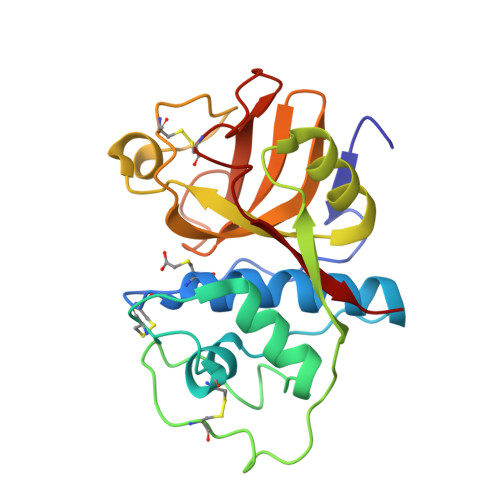The refined 2.4 A X-ray crystal structure of recombinant human stefin B in complex with the cysteine proteinase papain: a novel type of proteinase inhibitor interaction.
Stubbs, M.T., Laber, B., Bode, W., Huber, R., Jerala, R., Lenarcic, B., Turk, V.(1990) EMBO J 9: 1939-1947
- PubMed: 2347312
- DOI: https://doi.org/10.1002/j.1460-2075.1990.tb08321.x
- Primary Citation of Related Structures:
1STF - PubMed Abstract:
A stoichiometric complex of human stefin B and carboxymethylated papain has been crystallized in a trigonal crystal form. Data to 2.37 A resolution were collected using the area detector diffractometer FAST. The crystal structure of the complex has been solved by Patterson search techniques using papain as search model. Starting from the structure of chicken cystatin, the stefin structure was elucidated through cycles of model building and crystallographic refinement. The current crystallographic R factor is 0.19. Like cystatin, the stefin molecule consists of a five stranded beta-sheet wrapped around a five turn alpha-helix, but with an additional carboxy terminal strand running along the convex side of the sheet. Topological equivalence of stefin and cystatin reveal the previous sequence alignment to be incorrect in part, through deletion of the intermediate helix. The conserved residues form a tripartite wedge, which slots into the papain active site as proposed through consideration of the tertiary structures of the individual components (Bode et al., 1988). The main interactions are provided by the amino terminal 'trunk' (occupying the 'unprimed' subsites of the enzyme), and by the first hairpin loop, containing the highly conserved QVVAG sequence, with minor contributions from the second hairpin loop. The carboxyl terminus of stefin provides an additional interaction region with respect to cystatin. The interaction is dominated by hydrophobic contacts. Inhibition by the cysteine proteinase inhibitors is fundamentally different to that observed for the serine proteinase inhibitors.
Organizational Affiliation:
Max-Planck-Institut für Biochemie, Martinsried bei München, FRG.
















